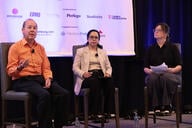You have /5 articles left.
Sign up for a free account or log in.
This is the time of year when my news reader is stuffed with articles and blog posts attempting to anticipate what’s ahead for higher ed in 2018.
It won’t surprise you to hear that there’s a lot to be concerned about.
I’ve just returned from CIC’s Presidents Institute. As Rick Seltzer, an Inside Higher Ed reporter, pointed out, the financial underpinnings of private colleges was one of the concerns discussed from the podium and, I’m sure, in private conversations throughout the conference. He noted,
Numerous presidents at the institute agreed that they see an increased urgency among their peers interested in exploring significant changes in order to stabilize their colleges' standing or seek long-term viability. In a few cases, presidents pointed to a confluence of trends causing them to reconsider doing business as usual, such as a declining number of traditional high school graduates in their regions, increased financial pressures, stiffer competition from public institutions or the free public college movement.
More often, presidents reported having long been aware of headwinds. But their Boards of Trustees, alumni and faculty members have recently become more open to making significant changes, they said.
How does one foster an environment where these key stakeholders are willing to consider options that were often dismissed a few years ago? Certainly, those who pay attention to the news are aware of the challenges individual institutions and the higher ed sector as a whole face. Those who don’t need to be reminded of higher ed’s increased vulnerability in these anxious times.
Take, for example, the public perception of higher ed. Seltzer didn’t mention it in his news report, but it was another topic of discussion at the Presidents Institute. For many reasons — the cost of higher ed, concerns about outcomes, politics — the reputation of higher education has taken a hit. The keynote speaker, David Leonhardt from The New York Times, talked about it, as did Valerie Jarrett, a senior adviser to President Obama.
Also, Jarrett urged presidents (and institutions) to stay engaged — or get engaged — in their communities. We need to strengthen relationships with community members and leaders, not just because it’s the right thing to do, but because we need their support. Just as we need the support of alumni leaders; state officials; business leaders; and trustees. We need them to speak out on our behalf about issues we care about and that affect the well-being of our institutions and the students we serve.
Creating this kind of engagement takes time and requires hard work. But this investment is as important to the long-term health of our institutions as a strong financial foundation.
Who among campus leaders is in the best position to lead this initiative?
Certainly presidents play an important role. And there are many others on campus who need to be involved. But it makes sense for these initiatives to be led or nurtured by the CMO. An effective CMO should have many of the key relationships in place already, both on campus and beyond.
If this sounds like more work, it is.
On the other hand, those who wish that higher ed was more like business can take heart. Some commentators imagine corporate CMOs becoming chief collaboration officers, synthesizing their knowledge of consumer behavior with data and insights and combining these insights to break down silos across the business. Higher ed CMOs who embrace the model of CMO as chief collaboration officer can take pride in leading in our sector — and establishing a model that peers in the business world can emulate, rather than vice versa.
Michael Stoner is president and co-founder of mStoner Inc., a digital-first agency committed to tailored solutions that deliver real results.




